Europe Intermodal Terminals Market Size
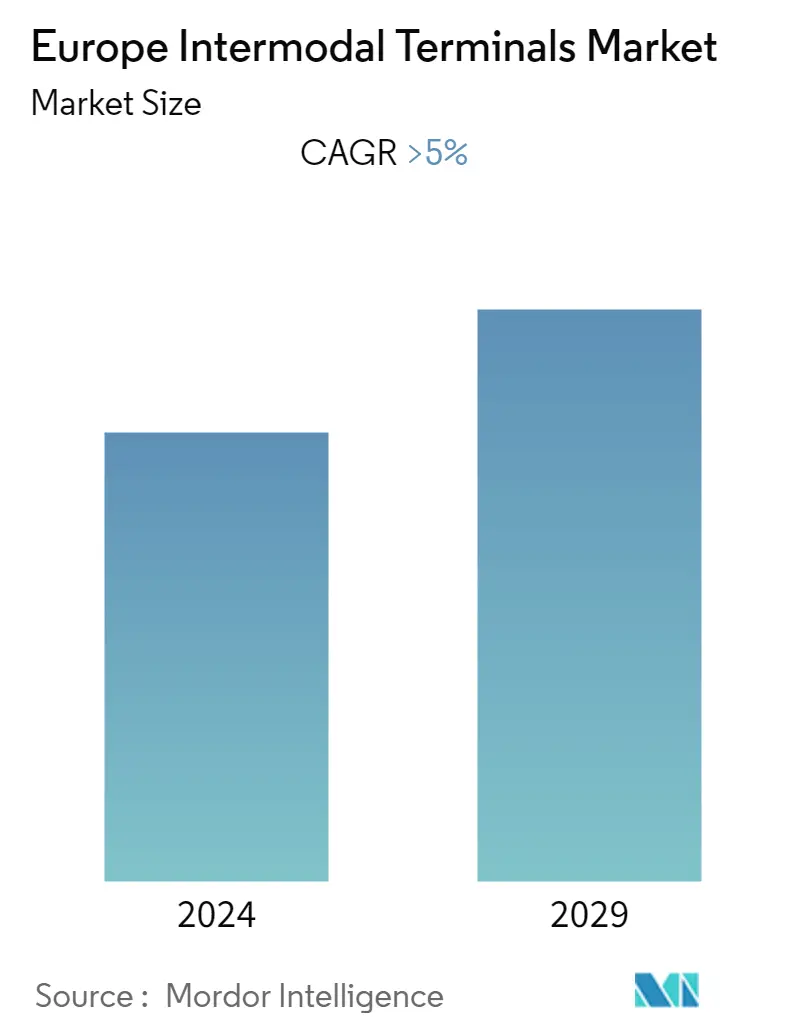
| Study Period | 2020 - 2029 |
| Base Year For Estimation | 2023 |
| Forecast Data Period | 2024 - 2029 |
| Historical Data Period | 2020 - 2022 |
| CAGR | 5.00 % |
| Market Concentration | Low |
Major Players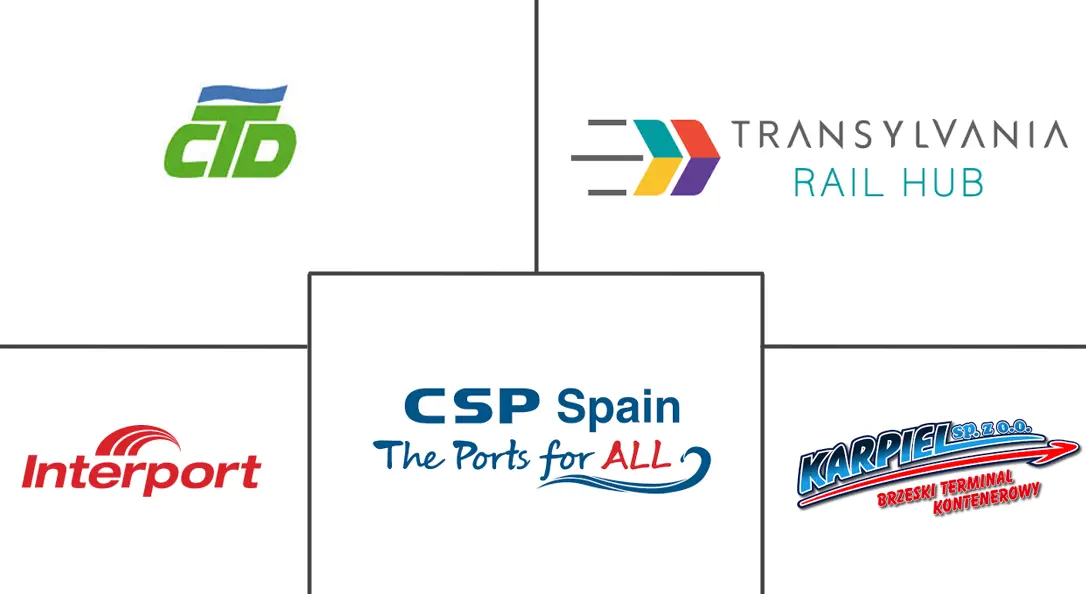
*Disclaimer: Major Players sorted in no particular order |
Europe Intermodal Terminals Market Analysis
The Europe Intermodal Termnals Market is expected to witness a CAGR of more than 5% through the forecast period.
The European Green Deal calls for a substantial part of the 75% of inland freight carried by road to shift to rail and inland waterways. This means in practice using intermodal transport, where the longest part of the journey is run on railways or on water, while only first and last mile is carried on road. This requires efficient transhipment facilities and technologies that make shifting loading units between the modes fast and cost efficient. The container is the most economical loading unit and vertical craning is more efficient than horizontal transhipment, including for semi-trailers, while some innovative technologies that can simultaneously lift several loadings units can reduce handling times in terminals.
The majority (60-80%) of transhipment capacity in the EU is provided by vertical transhipment technologies, followed by RoRo ships (20-35%). Only around 2% of transhipment capacity is today in other technologies. Importantly, by 2030, the transhipment capacity in the EU will not be sufficient to meet the demand of planned network capacity expansion. Therefore, the availability of terminals across the Trans-European Transport (TEN-T) network requires further investments and careful planning, considering that compatible transhipment solutions need to be available in both ends of a rail/waterborne leg. Furthermore, on many parts of the TEN-T network, structural upgrades are necessary to allow transporting semitrailers on train. Most upgrades are necessary in Spain, France and Italy, which together amount to 75% of such sections.
The required investment for the removal of these network limitations (loading gauge for semi-trailers, terminals with specific technology) is assessed being about 7.7 billion euros according to the according to the industry sources.
Europe Intermodal Terminals Market Trends
This section covers the major market trends shaping the Europe Intermodal Terminals Market according to our research experts:
Growth of Webshop Traffic Drives the Market
The years 2020 and 2021 have been exceptional due to the COVID-19 pandemic, particularly regarding e-commerce in Europe. Alongside the stringent (economic) measures taken to mitigate the spread of the virus, lockdowns (including closures of physical stores), and health/safety measures gave a boost to online shopping across Europe. In 2021, leading webshops in Europe witnessed an increase of 13% in web visitors as compared to 2020. In the first six months of 2021, web traffic grew by 8% compared to the same period in 2020, and by 18% compared to the same period in pre-COVID 2019.
The nature of webshops (i.e., sector, type, etc.) largely determines the extent to which they profited from the increase in online shopping due to the COVID-19 pandemic. For example, e-stores in the sectors of groceries, (alcoholic) beverages & pet supplies, as well as home & garden, witnessed the largest annual average increase in web traffic. On the contrary, webshops selling bicycles & (car) accessories experienced a decline in the number of visitors to their websites in 2021. To reiterate, these annual growth figures do not reflect the large fluctuations in web traffic due to COVID-19 measures over time, however, these figures offer insights into overall e-commerce market trends.
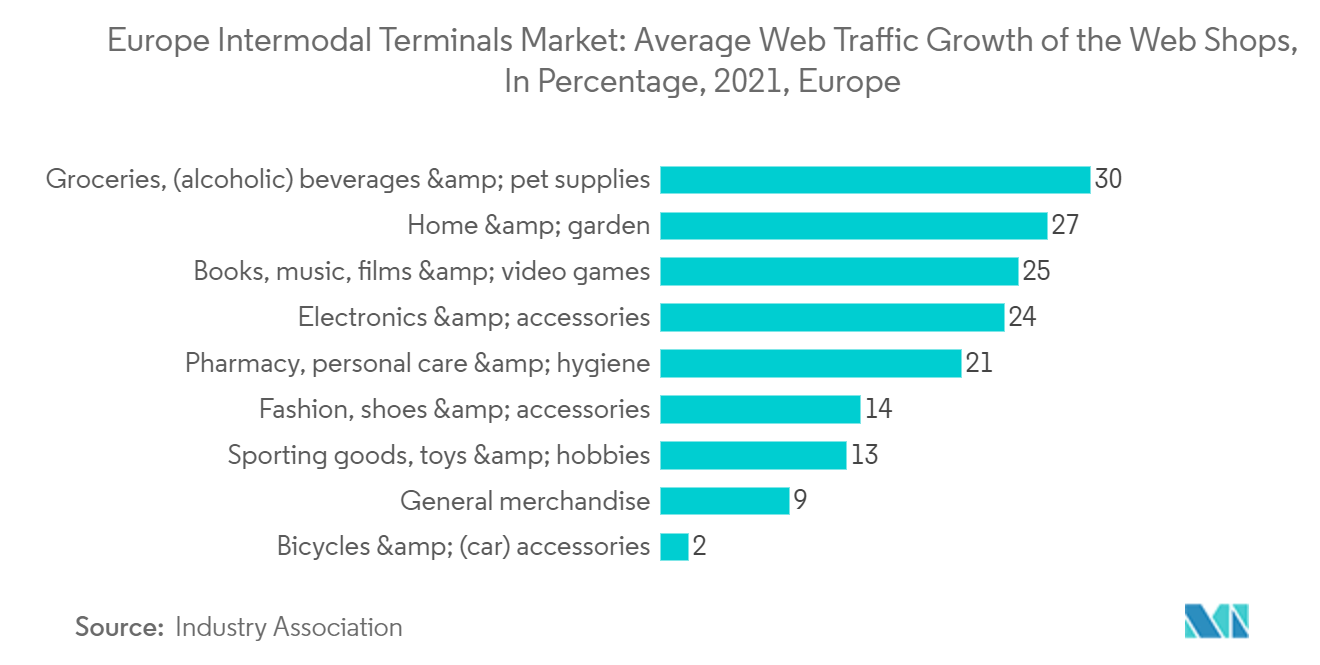
Increasing Start-ups and Warehousings Drive New Business Models in the Market
Most of the new entrants to the logistics sector are start-ups, and many of these are looking to use new technology to enter the industry. To date most of these are in 'asset light' parts of the value chain; for example, virtual freight forwarders. These assets or asset-light businesses exploit digital technology to offer interactive benchmarking of freight rates, or match shippers with available capacity.
Many of the new entrants in logistics are basing their offerings on more agile pricing. Some enable carriers to bid on loads, allowing them to lower their bids to fill up capacity. They're also providing quotes more quickly and increasing price transparency - for example, by linking via API directly to a large number of carriers, and providing customers with their negotiated rates for each of the carriers they use so they can compare directly.
Norwegian start-up Nimber matches commuters and travelers with consumers looking to ship something, whether it be a piano across the country or a skateboard or document across town. Technology players or technology-automotive collaborations may enter the industry, especially with ideas like self-driving lockers, or machine-to-machine parcel-station loading for last-mile delivery. Crowdsharing platforms may also emerge from autonomous vehicle development, or independently. As car-sharing increases, so may the use of the storage space available in these vehicles as a flexible way to expand capacity.
The industry's customers may also become significant new entrants. Amazon is an obvious example: it's looking to expand its in-house expertise in warehousing as well as develop its delivery capabilities. Hence its acquisition of a warehouse automation specialist, now part of its Amazon Robotics business unit. The company has leased 20 aircraft to handle more of its shipments15 and is piloting a 'Prime Air' 30-minute delivery offering using drones.16 Bloomberg has also reported that Amazon has plans to launch its own logistics offerings, a project allegedly referred to as 'Dragon Boat'.
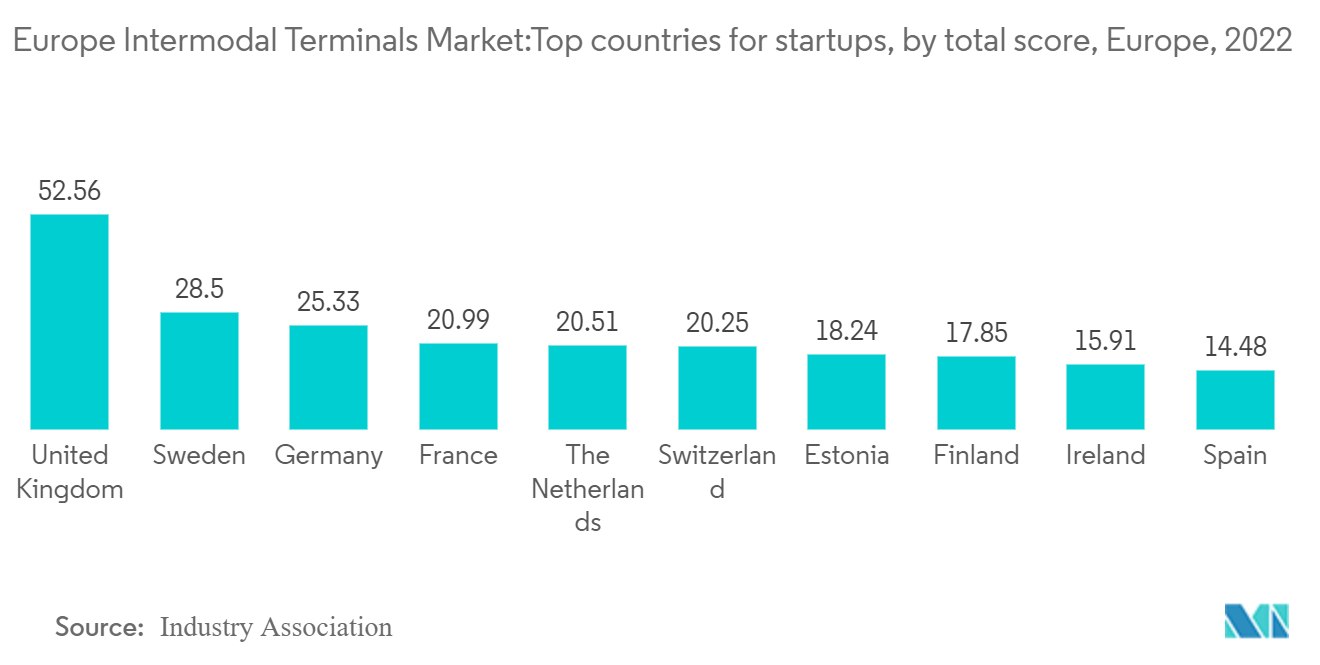
Europe Intermodal Terminals Industry Overview
The Europe Intermodal Terminals market is fragmented in nature, with a mix of global and regional players. The market is expected to grow during the forecast period due to several factors such as e-commerce, technology integration, and growing economies. The major companies in the country have adopted various modern technologies, such as warehousing management systems, automation, drone delivery, and the transportation management system, which has enabled better planning and tracking facilities, resulting in increased productivity and increased value proposition. Some of the major Players Include Container Terminal Dortmund GmbH (CTD) (Germany), COSCO SHIPPING Ports (Spain) Terminals, S.L.U., Rail Hub Transylvania, KARPIEL Sp. z o.o.etc.,
Europe Intermodal Terminals Market Leaders
-
Container Terminal Dortmund GmbH (CTD)
-
COSCO SHIPPING Ports (Spain) Terminals, S.L.U.
-
Rail Hub Transylvania
-
DP World Southampton
-
DP World Logistics Europe GmbH
*Disclaimer: Major Players sorted in no particular order
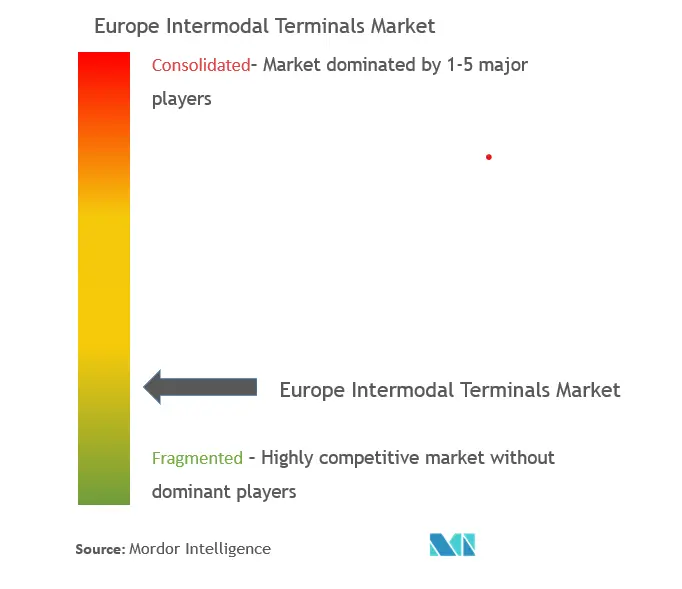
Europe Intermodal Terminals Market News
- November 2022: CSP Spain Inaugurated a new express service between Spain and Turkey in the Valencian terminal of CSP Spain. The service is promoted by the company Cordelia Container Shipping Line and among its stops, the Valencian terminal of CSP Spain. It is a weekly service, with two vessels involved with an approximate capacity of 700 TEUS.
- October 2022: In October, an unprecedented operation of special projects was carried out successfully in the Valencian terminal of CSP Spain. The unloading of 3 yachts from the ship into the water was carried out from the APL Savannah ship, coming from Australia, thanks to the collaboration of all the agents involved. CSP Iberian Valencia terminal has expert personnel and the necessary machinery: spreaders, slings and hooks under a gantry crane with the capacity and dimensions necessary for safe handling. This type of activity is more complex than the typical loading of the container terminal and has been possible thanks to the coordination of all the agents involved, from the maritime line client CMA CGM, Peters & May, world leader in yacht operations, and the rest. of the parties involved in the port of Valencia.
Europe Intermodal Terminals Market Report - Table of Contents
1. INTRODUCTION
- 1.1 Study Assumptions
- 1.2 Scope of the Study
2. RESEARCH METHODOLOGY
3. EXECUTIVE SUMMARY
4. MARKET INSIGHTS
- 4.1 Current Market Scenario
- 4.2 Government Regulations and Initiatives
- 4.3 Technological Trends in the Market
- 4.4 Insights into the E-commerce Industry
- 4.5 Insights into Supply Chain Planning In Europe
- 4.6 Insights into the Courier, Express, and Parcel Industry (CEP)
- 4.7 Insights into Intermodal Transportation and Dry Ports
- 4.8 Brief on Freight Transportation Costs/Freight Rates, Warehousing Rents in Europe
- 4.9 Brief on Transport Corridors in the Region
- 4.10 Industry Value/Supply Chain Analysis
- 4.11 Impact of COVID-19 on the Market
5. MARKET DYNAMICS
- 5.1 Market Drivers
- 5.2 Market Restraints
- 5.3 Market Opportunities
-
5.4 Porter's Five Forces Analysis
- 5.4.1 Bargaining Power of Suppliers
- 5.4.2 Bargaining Power of Consumers/Buyers
- 5.4.3 Threat of New Entrants
- 5.4.4 Threat of Substitute Products
- 5.4.5 Intensity of Competitive Rivalry
6. MARKET SEGMENTATION
-
6.1 By Transportation Mode
- 6.1.1 Rail and Road Transport
- 6.1.2 Air and Road Transport
- 6.1.3 Maritime and Road Transport
-
6.2 By End-User
- 6.2.1 Manufacturing and Automotive
- 6.2.2 Oil, Gas, and Mining
- 6.2.3 Agriculture, Fishing, and Forestry
- 6.2.4 Construction
- 6.2.5 Distributive Trade
- 6.2.6 Others
-
6.3 By Geography
- 6.3.1 Germany
- 6.3.2 France
- 6.3.3 United Kingdom
- 6.3.4 Spain
- 6.3.5 Rest of Europe
7. COMPETITIVE LANDSCAPE
- 7.1 Overview (Market Concentration and Major Players)
-
7.2 Company Profiles
- 7.2.1 Container Terminal Dortmund GmbH (CTD) (Germany)
- 7.2.2 COSCO SHIPPING Ports (Spain) Terminals, S.L.U.(Spain)
- 7.2.3 Rail Hub Transylvania(Romania)
- 7.2.4 INTERPORT Terminal Kosice(Romania)
- 7.2.5 KARPIEL Sp. z o.o.(Poland)
- 7.2.6 Rail Cargo Group(Austria)
- 7.2.7 DP World Southampton(United Kingdom)
- 7.2.8 DP World Logistics Europe GmbH(Germany)
- 7.2.9 EuroTerminal Emmen-Coevorden-Hardenberg b.v.(Netherlands)
- 7.2.10 Combinant NV(Belgium)
- *List Not Exhaustive
8. FUTURE OUTLOOK OF THE MARKET
9. APPENDIX
** Subject To AvailablityEurope Intermodal Terminals Industry Segmentation
Intermodal terminals play a significant role in the consolidation, storage and transfer of freight between rail and road at the beginning and end of each rail journey. Intermodal terminals provide connectivity to ports, regional networks and other capital cities and locations.
The Europe Intermodal Terminals Market is segmented by Transportation Mode (Rail and Road Transport, Air and Road Transport, Maritime and Road Transport), End-User Industry (Manufacturing, Oil and Gas, Consumer and Retail, Aerospace and Defense, Energy and Mining), and Geography. and by Geography(Germany, France, United Kingdom, Spain and Rest of Europe). The report offers market size and forecast values (USD billion) for all the above segments.
Europe Intermodal Terminals Market Research FAQs
What is the current Europe Intermodal Terminals Market size?
The Europe Intermodal Terminals Market is projected to register a CAGR of greater than 5% during the forecast period (2024-2029)
Who are the key players in Europe Intermodal Terminals Market?
Container Terminal Dortmund GmbH (CTD) , COSCO SHIPPING Ports (Spain) Terminals, S.L.U., Rail Hub Transylvania, DP World Southampton and DP World Logistics Europe GmbH are the major companies operating in the Europe Intermodal Terminals Market.
What years does this Europe Intermodal Terminals Market cover?
The report covers the Europe Intermodal Terminals Market historical market size for years: 2020, 2021, 2022 and 2023. The report also forecasts the Europe Intermodal Terminals Market size for years: 2024, 2025, 2026, 2027, 2028 and 2029.
Europe Intermodal Terminals Industry Report
Statistics for the 2024 Europe Intermodal Terminals market share, size and revenue growth rate, created by Mordor Intelligence™ Industry Reports. Europe Intermodal Terminals analysis includes a market forecast outlook to 2029 and historical overview. Get a sample of this industry analysis as a free report PDF download.



